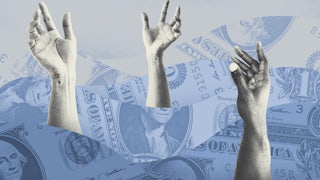Millions of renters who have been unable to pay their rent during the Covid-19 pandemic received a temporary, last-minute reprieve last month when the Centers for Disease Control and Prevention extended the federal eviction moratorium to the end of July. But to people like Cristina Livingston, who lost her job as an administrative assistant earlier in the pandemic and whose landlord has refused to take federal assistance to cover her back rent, it won’t be enough to keep her in her home. Instead, it merely pushed back the timeline of an eviction her landlord was committed to carrying out. “I’m just asking for a little bit more time,” the 55-year-old Livingston told the Associated Press in June, adding that the extra 30 days could act as a buffer to help her find a new place to live. “I just need the time to move out of here in a dignified way.” A woman in Denver facing eviction but for the moratorium put it more vividly. “It felt like medieval times,” she told a local news station. “There’s an ax just lowering over your head, and your head is about to get cut off.”
That ax is going to fall, and soon. As the CDC’s press release made clear, June’s extension would likely be the last. It was just a delay of the inevitable—come August 1, housing courts will likely be filled once again with landlords clamoring to evict their tenants. (In some states, such as New York and California, which have extended their own moratoriums, that due date will merely come later.) The numbers paint a dire portrait of precarity: Twice as many households have fallen behind on their rent during the pandemic compared to before Covid-19, and some studies estimate that more than six million households now have rent debt and therefore are at risk of eviction, an existing crisis exacerbated by the pandemic and one that is disproportionately destabilizing Black, Latinx, and low-income families. While Congress approved billions of dollars in emergency rental assistance meant to help people pay off their rent debt, that relief has been slow in coming, in part due to the onerous, unwieldy application process that many states have created, one seemingly designed to make it as difficult as possible to access its benefits; in some instances, landlords have refused to accept that federal assistance at all, making the calculation that in the long run, clearing out their tenants now will maximize their future profits. As we look to the fall, the worst-case scenario is one that housing organizers have been warning about for months—in the words of Diane Yentel, the head of the National Low-Income Housing Coalition, we can expect a “historic wave of evictions and housing instability.” The best-case scenario isn’t much better: stressed renters scrambling to obtain relief and wasting time, money, and energy to fight their landlords in housing court.
Other pandemic relief programs are set to expire in the coming weeks and months, in what will amount to a cascading wave of delayed, and wholly unnecessary, pain. In September, the federal government’s enhanced unemployment benefits will end, a phaseout that has already occurred in the more than two dozen largely Republican-led states that cut off their residents months before the federal expiration date. (That’s if you were able to access the system to begin with—according to a recent analysis by Bloomberg Businessweek, nine million people who lost work during the pandemic didn’t receive any unemployment benefits at all, amounting to “a hole in the safety net as big as the population of Virginia.”) And on September 30, after more than a year of relief, more than 40 million people with federal student loans will need to resume paying off their debt. For many people, that burden will once again become a crushing financial weight—according to a survey by the advocacy group Student Debt Crisis, 90 percent of people the group spoke with said that they’re financially unready to resume payments. If forced to do so, one out of three people reported that more than a quarter of their income will go toward servicing their student loan debt.
As The New York Times noted about the expiration of these relief programs, the “pandemic safety net is coming apart.” It was always meant to unravel, built as it was upon the idea—now shown to be wishful thinking—that the pandemic would have a predictable end point. (The pandemic still isn’t over, a fact lost on many people in power right now.) For all that these lifelines have benefited millions of Americans, their temporary nature has a built-in cruelty—it says: We’ll give you a taste of what a less precarious life might look like, but just a taste. We’ll take the boot off your neck, but not for good—and when it returns, it’ll feel even more crushing.
But these temporary benefits have sown the seeds of what our future could look like—the power of even half-measures to make a material difference in people’s lives, to give people just a little more breathing room. This month, we’ve seen it again as people started receiving their monthly child tax credit checks, the result of a provision passed by Democrats in the last round of Covid relief. It, too, is meant to be temporary, though some Democrats are pushing for it to be permanent. Parents have described using the extra cash—typically a few hundred dollars per month, per child—to purchase new clothes for their growing children, to help pay childcare workers a decent wage, to pay off credit card debt, to buy a big box of diapers from Costco, to go on a small family vacation, to chip away at medical debt. There’s something obscene and depressing about our collective pandemic experience: that it took mass death and suffering to spur the direct government intervention that allowed millions of others to experience—many for the first time—something like financial stability. There’s no good reason, especially as the pandemic drags on, to steal back that small comfort.








